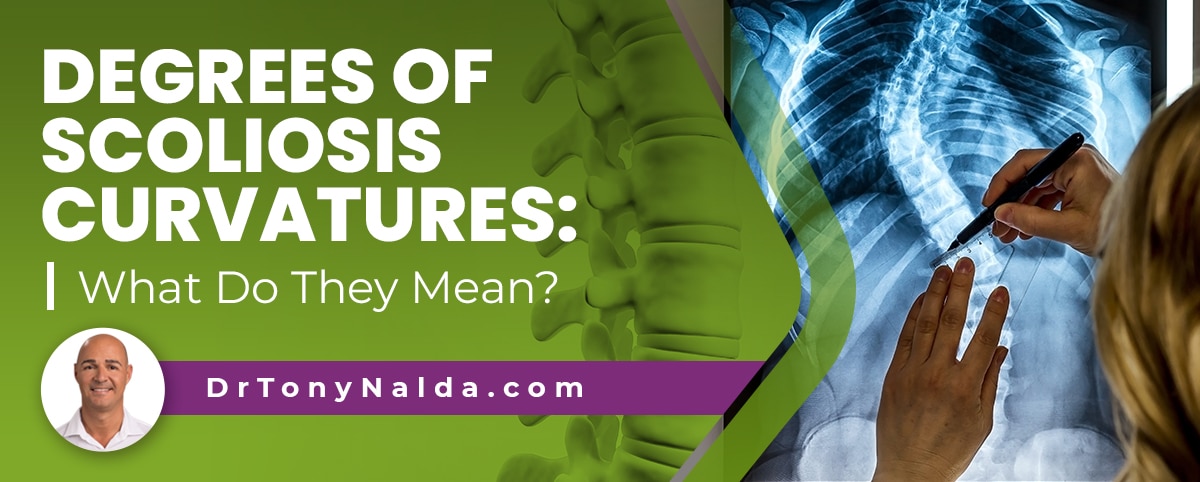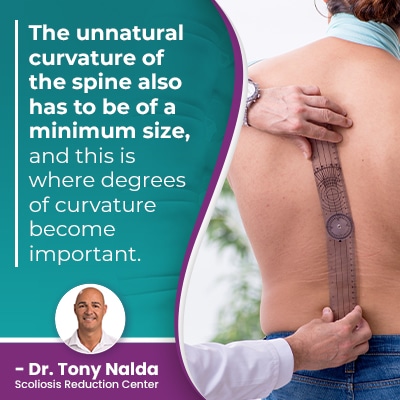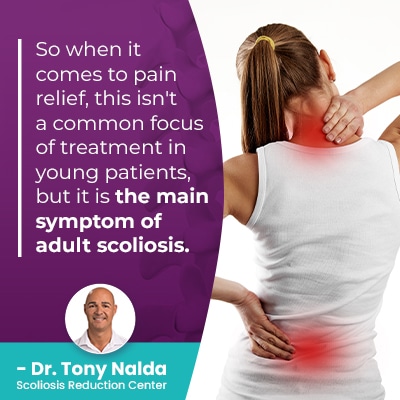Degrees of Scoliosis Curvatures: What Do They Mean?

Just as the spine's natural and healthy curves range in size, so can its unhealthy curves. Different degrees of scoliosis curvatures are referring to their size and severity level, and the more severe a condition, the more complex it is to treat, the more likely it is to experience further progression, and the more likely it is to cause noticeable symptoms.
Scoliosis ranges in severity from mild scoliosis to very-severe scoliosis, and severity is a key classification point that treatment plans are shaped around. A measurement known as Cobb angle places conditions on a severity scale.
Scoliosis diagnosed early and treated with active treatment disciplines can help achieve a curvature reduction, but let's start with exploring how to diagnose scoliosis.
Table of Contents
How to Diagnose Scoliosis
In order to reach a diagnosis of scoliosis, certain guidelines have to be met.
Scoliosis is the development of an unnatural spinal curve that bends to the side and rotates, making it a 3-dimensional condition.
 The unnatural curvature of the spine also has to be of a minimum size, and this is where degrees of curvature become important.
The unnatural curvature of the spine also has to be of a minimum size, and this is where degrees of curvature become important.
Scoliosis can develop in any of the spine's main sections: cervical spine (neck), thoracic spine (middle/upper back), and the lumbar spine (lower back).
In order to be considered a true scoliosis, it has to be at least 10 degrees, and curvature degree is determined by a measurement known as Cobb angle.
Cobb Angle and Condition Severity
A patient's Cobb angle is a key piece of information when it comes to diagnosing and assessing scoliosis.
The diagnostic cutting point is 10 degrees, and this was suggested, somewhat arbitrarily, by a Dr. William Kane in a 1977 article entitled Scoliosis Prevalence: A Call for a Statement of Terms.
In the article, Kane explores the issues that can arise when there isn't a consistent process of diagnosis, with different doctors and scientists using a variety of curvature degrees to diagnose/assess scoliosis.
Less than 10 degrees was suggested as too minor, while more than 10 degrees was considered too severe, so 10 degrees became the diagnostic cut-off point for scoliosis, still used today.
One of the reasons consistency is so important is that as a progressive condition, where a scoliosis is at the time of diagnosis doesn't mean that's where it will stay without treatment.
Scoliosis is Progressive
Scoliosis has it in its nature to get worse over time, meaning the unnatural spinal curve will increase in size over time, as will the condition's uneven forces, and their effects.
In a healthy spine with its natural curves in place, the vertebrae (bones of the spine) are stacked on top of one another in a straight and neutral alignment, but as scoliosis develops, some vertebrae become tilted, shifting them out of alignment with the rest of the spine.
As an unnatural spinal curve develops, a lot of uneven forces are being introduced to the spine, its surrounding muscles and nerves, and the rest of the body.
The condition's progressive line is the same as its severity levels: mild to very severe.
The higher a patient's Cobb angle, the more severe the condition, and the more likely further progression is:
- Mild scoliosis: Cobb angle measurement of between 10 and 25 degrees
- Moderate scoliosis: Cobb angle measurement of between 25 and 40 degrees
- Severe scoliosis: Cobb angle measurement of 40+ degrees
- Very-severe scoliosis: Cobb angle measurement of 80+ degrees
Only proactive treatment disciplines can help work towards counteracting the condition's progressive nature.
While we don't always know why scoliosis develops, we do know how to treat it, and we do understand what triggers its progression: growth.
Now that we've defined the condition and explored the parameters that have to be met in order to reach a diagnosis of scoliosis, let's take a look at the main severity levels to see what the different curvature degrees mean in terms of living with scoliosis.
Mild Scoliosis
Mild scoliosis is diagnosed with a scoliotic curve that's between 10 and 25 degrees.
At this level, the condition isn't always overt, with subtle symptoms that can go unnoticed until further progression has occurred.
In addition to different severity levels, there are also different condition types, determined by causation: another important classification point.
The main type of scoliosis is adolescent idiopathic scoliosis (AIS), diagnosed between the ages of 10 and 18, which is the type we'll focus on for our current purposes.
The idiopathic classification means cause unknown, and idiopathic scoliosis accounts for approximately 80 percent of known diagnosed scoliosis cases, with the remaining 20 percent consisting of types associated with known causes: neuromuscular scoliosis, degenerative scoliosis, and congenital scoliosis.
As adolescents are in, or entering into, the stage of puberty, characterized by rapid and unpredictable growth spurts, they are at risk for rapid-phase progression, which is why early detection can increase chances of treatment success.
The main symptoms of mild adolescent scoliosis involve postural deviation:
- Uneven shoulders
- Uneven shoulder blades
- Uneven hips
As mentioned, at this level, these changes can be subtle and difficult for anyone, other than an expert, to notice, which is why awareness of the condition's early indicators is so important for parents and/or caregivers.
So let's move on to the next level of progression: moderate scoliosis.
Moderate Scoliosis
Moderate scoliosis curves are between 25 and 40 degrees.
The majority of my patients are in the moderate stage of progression as it's when a condition progresses from mild to moderate that its subtle signs, and related symptoms, tend to become more noticeable.
Again, the main signs of moderate scoliosis in adolescents are postural deviation, but the changes are more overt at this level:
- Head uncentered over the torso
- Uneven eye line
- Uneven shoulders
- Uneven shoulder blades
- The development of a rib arch
- Uneven hips
- Arms and legs that appear to hang at different lengths
The condition's uneven forces disrupt the body's overall symmetry and can also cause changes to balance, coordination, and gait.
An interesting thing about child and adolescent idiopathic scoliosis is that in most cases, other than related muscle pain, the condition isn't commonly painful; this is due to compression and skeletal maturity.
In young patients whose spines are still growing, the condition has not yet become compressive, which happens once skeletal maturity has been reached.
Growing spines are experiencing a constant lengthening motion that counteracts the compressive force of the unnatural spinal curve, and it's compression of the spine and its surrounding muscles and nerve compression that causes the majority of pain in adult scoliosis.
 So when it comes to pain relief, this isn't a common focus of treatment in young patients, but it is the main symptom of adult scoliosis.
So when it comes to pain relief, this isn't a common focus of treatment in young patients, but it is the main symptom of adult scoliosis.
With moderate adolescent scoliosis, proactive treatment strives to prevent further progression into severe scoliosis as this is when, for those undergoing traditional treatment, scoliosis surgery is commonly recommended.
Let's now move on to exploring severe scoliosis.
Severe Scoliosis
When a scoliosis diagnosis of severe scoliosis is reached, the curvature degree falls at 40+ degrees, with very severe scoliosis curvature degrees progressing to 80+ degrees.
At this level of adolescent idiopathic scoliosis, its symptoms are overt, and postural deviation can be severe, along with the unnatural spinal curvature being visible to the naked eye.
Scoliosis treatment for severe scoliosis will depend on which of the two main scoliosis treatment approaches a patient commits to.
Traditional treatment does little before a condition becomes severe because they don't have a strategy for treating scoliosis while mild.
Watching and waiting is commonly recommended, and if a patient's spine progresses into the severe classification, further progression is more likely, making them surgical candidates.
Surgical treatment for scoliosis is invasive, costly, and risky, so the goal of proactive treatment is to prevent progressing to this point to spare patients the hardships associated with increasing symptoms and the risks associated with spinal fusion surgery.
Symptoms of severe scoliosis can include:
- Overt levels of postural deviation
- A prominent lean to one side
- Unnatural spinal curve that's visible to the naked eye
- Muscle pain
- Back pain and nerve pain (more common in adult scoliosis)
At this level, clothing can become ill-fitting due to the condition's disruption of the body's overall symmetry and changes to posture, gait, and balance can make certain activities difficult, leading to activity restrictions that can impact quality of life.
Traditional treatment is delivered by an orthopedic surgeon that will push for invasive surgery to treat scoliosis, but the reality is many cases of scoliosis can be treated with nonoperative treatment, known as conservative treatment and/or functional treatment.
Conclusion
When it comes to how the different degrees of an abnormal curvature of the spine affect patients, we're talking about symptoms of postural deviation, pain, and how the condition is treated.
While the traditional approach recommends mild scoliosis patients should watch and wait, for a proactive treatment approach, this is wasting valuable treatment time.
Also known as the functional treatment approach, conservative treatment values starting treatment as close to the time of diagnosis as possible, when the condition is at its mildest, is the simplest to treat, and success is the most likely.
While the traditional treatment approach commonly funnels patients towards the surgical threshold, functional treatment wants to prevent this through integrating chiropractic adjustments to address the condition's underlying structural nature, corrective bracing, scoliosis specific therapy, and rehabilitation.
Here at the Scoliosis Reduction Center, based on a patient's degree of curvature, and a number of other important patient/condition factors, scoliosis effects can be minimized with a proactive treatment plan that can slow progression, prevent significant progression, and reduce the unnatural spinal curve on a structural level.
Dr. Tony Nalda
DOCTOR OF CHIROPRACTIC
After receiving an undergraduate degree in psychology and his Doctorate of Chiropractic from Life University, Dr. Nalda settled in Celebration, Florida and proceeded to build one of Central Florida’s most successful chiropractic clinics.
His experience with patients suffering from scoliosis, and the confusion and frustration they faced, led him to seek a specialty in scoliosis care. In 2006 he completed his Intensive Care Certification from CLEAR Institute, a leading scoliosis educational and certification center.
About Dr. Tony Nalda
 Ready to explore scoliosis treatment? Contact Us Now
Ready to explore scoliosis treatment? Contact Us Now





